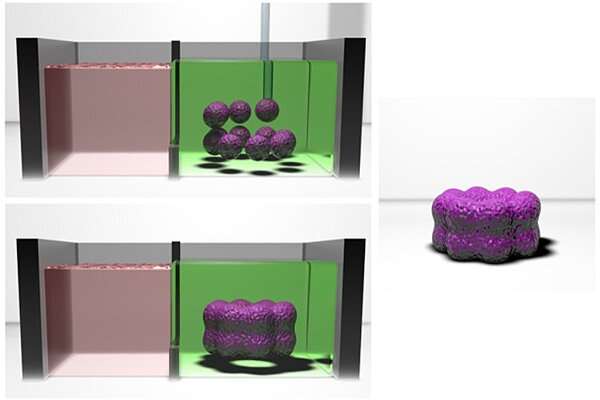New bioprinting technique allows for complex microtissues

Bioprinting is currently used to generate model tissues for research and has potential applications in regenerative medicine. Existing bioprinting techniques rely on printing cells embedded in hydrogels, which results in low-cell-density constructs that are well below what is required to grow functional tissues. Maneuvering different kinds of cells into position to replicate the complex makeup of an organ, particularly at organlike cell densities, is still beyond their capabilities.
Now, researchers at the School of Engineering and Applied Science have demonstrated a new bioprinting technique that enables the bioprinting of spatially complex, high-cell-density tissues.
Using a self-healing hydrogel that allows dense clusters of cells to be picked and placed in a three-dimensional suspension, the researchers constructed a model of heart tissue that featured a mix of cells that mimic the results of a heart attack.
The study was led by Jason Burdick, Robert D. Bent Professor in the Department of Bioengineering, and Andrew C. Daly, a postdoctoral researcher in his lab. Fellow Burdick lab postdoc Matthew Davidson also contributed to the study, which has been published in the journal Nature Communications.
Even without a bioprinter, groups of cells can be made to clump into larger aggregates, known as spheroids. For Burdick and colleagues, these spheroids represented a potential building block for a better approach to bioprinting.
"Spheroids are often useful for studying biological questions that rely on the cells' 3-D microenvironments or in the construction of new tissues," says Burdick. "However, we'd like to produce even higher levels of organization by 'printing' different kinds of spheroids in specific arrangements and have them fuse together into structurally complex microtissues."
More information: Andrew C. Daly et al. 3D bioprinting of high cell-density heterogeneous tissue models through spheroid fusion within self-healing hydrogels, Nature Communications (2021). DOI: 10.1038/s41467-021-21029-2
Journal information: Nature Communications
Provided by University of Pennsylvania



















